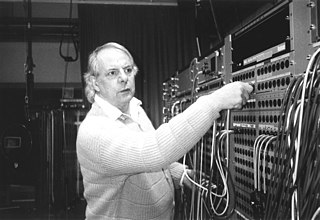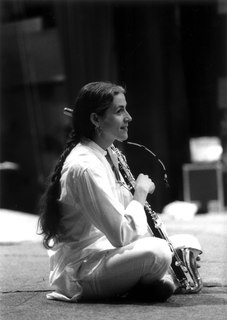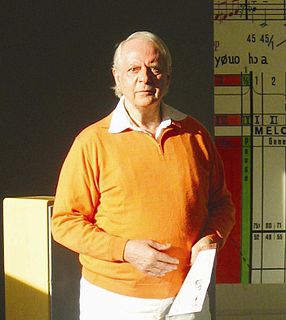Related Research Articles

Karlheinz Stockhausen was a German composer, widely acknowledged by critics as one of the most important but also controversial composers of the 20th and early 21st centuries. He is known for his groundbreaking work in electronic music, for introducing controlled chance into serial composition, and for musical spatialization.

In music, tape loops are loops of magnetic tape used to create repetitive, rhythmic musical patterns or dense layers of sound when played on a tape recorder. Originating in the 1940s with the work of Pierre Schaeffer, they were used among contemporary composers of 1950s and 1960s, such as Éliane Radigue, Steve Reich, Terry Riley, and Karlheinz Stockhausen, who used them to create phase patterns, rhythms, textures, and timbres. Popular music authors of 1960s and 1970s, particularly in psychedelic, progressive and ambient genres, used tape loops to accompany their music with innovative sound effects. In the 1980s, analog audio and tape loops with it gave way to digital audio and application of computers to generate and process sound.

Licht (Light), subtitled "Die sieben Tage der Woche", is a cycle of seven operas composed by Karlheinz Stockhausen between 1977 and 2003. The composer described the work as an "eternal spiral" because "there is neither end nor beginning to the week." Licht consists of 29 hours of music.

The Helikopter-Streichquartett is one of Karlheinz Stockhausen's best-known pieces, and one of the most complex to perform. It involves a string quartet, four helicopters with pilots, as well as audio and video equipment and technicians. It was first performed and recorded in 1995. Although performable as a self-sufficient piece, it also forms the third scene of the opera Mittwoch aus Licht.

Kontakte ("Contacts") is an electronic music work by Karlheinz Stockhausen, realized in 1958–60 at the Westdeutscher Rundfunk (WDR) electronic-music studio in Cologne with the assistance of Gottfried Michael Koenig. The score is Nr. 12 in the composer's catalogue of works, and is dedicated to Otto Tomek.

The Klavierstücke constitute a series of nineteen compositions by German composer Karlheinz Stockhausen.

Klang —Die 24 Stunden des Tages is a cycle of compositions by Karlheinz Stockhausen, on which he worked from 2004 until his death in 2007. It was intended to consist of 24 chamber-music compositions, each representing one hour of the day, with a different colour systematically assigned to every hour. The cycle was unfinished when the composer died, so that the last three "hours" are lacking. The 21 completed pieces include solos, duos, trios, a septet, and Stockhausen's last entirely electronic composition, Cosmic Pulses. The fourth composition is a theatre piece for a solo percussionist, and there are also two auxiliary compositions which are not part of the main cycle. The completed works bear the work (opus) numbers 81–101.

Trans is a composition for orchestra and tape by the German composer Karlheinz Stockhausen, written in 1971. It is Number 35 in the composer's catalog of works.

Suzanne Stephens is an American clarinetist, resident in Germany, described as "an outstanding performer and tireless promoter of the clarinet and basset horn".

Kathinka Pasveer is a Dutch flautist.

In Freundschaft is a composition by Karlheinz Stockhausen, number 46 in his catalogue of works. It is a serial composition for a solo instrument, first for clarinet, and later arranged by the composer for many other instruments, often in friendship to specific performers.

Sonntag aus Licht is an opera by Karlheinz Stockhausen in five scenes and a farewell, to a libretto written and compiled by the composer. It is the last-composed of seven operas that comprise the cycle Licht (Light). Its stage premiere in 2011 was posthumous, more than three years after the composer's death.

Samstag aus Licht is an opera by Karlheinz Stockhausen in a greeting and four scenes, and was the second of seven to be composed for the opera cycle Licht: die sieben Tage der Woche. It was written between 1981 and 1983, to a libretto written by the composer and incorporating a text by Saint Francis of Assisi, and was first staged in Milan in 1984.

Dienstag aus Licht is an opera by Karlheinz Stockhausen in a greeting and two acts, with a farewell, and was the fourth of seven to be completed for the opera cycle Licht: Die sieben Tage der Woche. It was begun in 1977 and completed from 1988 to 1991, to a libretto by the composer.

Mittwoch aus Licht is an opera by Karlheinz Stockhausen in a greeting, four scenes, and a farewell. It was the sixth of seven to be composed for the opera cycle Licht: die sieben Tage der Woche, and the last to be staged. It was written between 1995 and 1997, and first staged in 2012.

Mixtur, for orchestra, 4 sine-wave generators, and 4 ring modulators, is an orchestral composition by the German composer Karlheinz Stockhausen, written in 1964, and is Nr. 16 in his catalogue of works. It exists in three versions: the original version for full orchestra, a reduced scoring made in 1967, and a re-notated version of the reduced scoring, made in 2003 and titled Mixtur 2003, Nr. 162⁄3.

Strahlen (Rays) for a percussionist and ten-channel sound recording is a composition by Karlheinz Stockhausen, and is Nr. 80½ in his catalog of works. Its performing duration is 35 minutes.

Octophonic sound is a form of audio reproduction that presents eight discrete audio channels using eight speakers. For playback, the speakers may be positioned in a circle around the listeners or in any other configuration.

Oktophonie (Octophony) is a 1991 octophonic electronic-music composition by Karlheinz Stockhausen. A component layer of act 2 of the opera Dienstag aus Licht, it may also be performed as an independent composition. It has a duration of 69 minutes.
Spiel is a two-movement orchestral composition by Karlheinz Stockhausen, written in 1952. Withdrawn by the composer after its first performance, it was later revised and restored to his catalogue of works, where it bears the work-number ¼. The score is dedicated to the composer's first wife, Doris.
References
- ↑ ARTSaha! program, Accessed: November 12, 2011.
- 1 2 Collins, Nick (Spring 2008). "Karlheinz Stockhausen: Cosmic Pulses". Computer Music Journal . Pattern Discovery and the Laptop Orchestra. 32 (1): 90.
- 1 2 3 Nordin, Ingvar Loco. "Karlheinz Stockhausen – Edition 91: Cosmic Pulses". Accessed: November 12, 2011.
- ↑ COSMIC PULSES, 13th Hour of KLANG (SOUND) (archive from 4 April 2014; accessed 20 July 2015).
- ↑ Stockhausen, Karlheinz. Stockhausen-Courses Kuerten 2007: Composition Course on KLANG/SOUND, the 24 Hours of the Day: Second Hour: FREUDE for Two Harps, 2005, Work No. 82. Kürten: Stockhausen-Verlag, 2007.
- 1 2 Program from the world premiere performance. (pdf)
- ↑ Stockhausen, Karlheinz. Jerusem. Kürten: Stockhausen-Verlag, 2007. p. III
- ↑ Walls, Seth Colter. Das Reboot at Issue Project Room, December 12, 2011.
- 1 2 Stockhausen, Karlheinz. Cosmic Pulses, CD Liner Notes. Kürten: Stockhausen-Verlag, 2007.
- 1 2 3 4 5 6 Collins 2008 , p. 89
- ↑ Stockhausen, Karlheinz. Orvonton. Kürten: Stockhausen-Verlag. 2007, pp. III–IV.
- ↑ Anon. "Jubiläum: 40 Jahre Experimentalstudio des SWR" (Stuttgart, Baden-Baden, Mainz: SWR.de, 2011) (Accessed 14 December 2011)
- ↑ Karlheinz Stockhausen, Kompositions-Kurs über SIRIUS, Elektronische Musik und Trompete, Sopran, Baßklarinette, Baß (1975–77) (Kürten: Stockhausen-Verlag, 2000): 43–44.
- ↑ Karlheinz Stockhausen, Mantra für 2 Pianisten (1970), Werk Nr. 32 (score) (Kürten: Stockhausen-Verlag, 1975): i, iv, and vii)
- ↑ Karlheinz Stockhausen, "Osaka-Projekt: Kugelauditorium EXPO 70", in his Texte zur Musik 3, edited by Dieter Schnebel, 153–187, DuMont Dokumente (Cologne: Verlag M. DuMont Schauberg). Citation on p. 167.
- ↑ Emberley, Nick. "Stock Exchanges", Evening Standard , August 4, 2008.
- ↑ Morrison, Richard. "Stockhausen Day", The Times , August 4, 2008.
- ↑ Driver, Paul. "Mister Universe", The Sunday Times , August 10, 2008.
- ↑ Allison, John. "Music's Deep Spaceman", The Sunday Telegraph . August 10, 2008.
- ↑ Hall, George. "After the orchestral brawl, an intergalactic bunfight", The Independent on Sunday . August 10, 2008.
- ↑ Hewett, Ivan. "Sound of a Cosmic Giant", The Daily Telegraph . August 4, 2008.
- ↑ Clements, Andrew. "Review: Proms 20 & 21: Stockhausen Day Royal Albert Hall, London 4/5", The Guardian . August 4, 2008.
